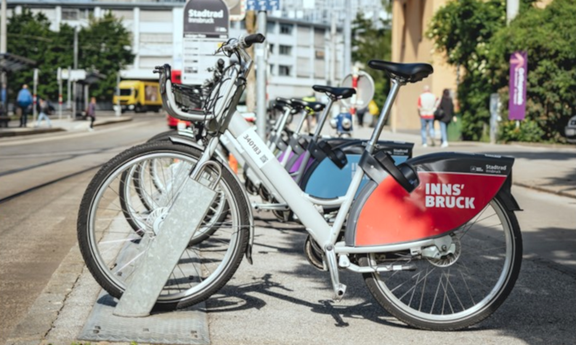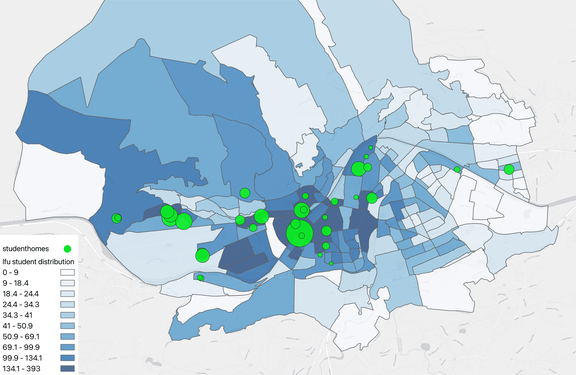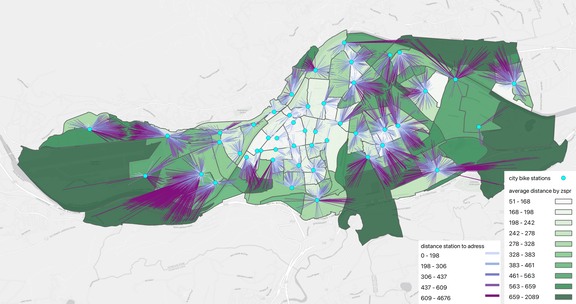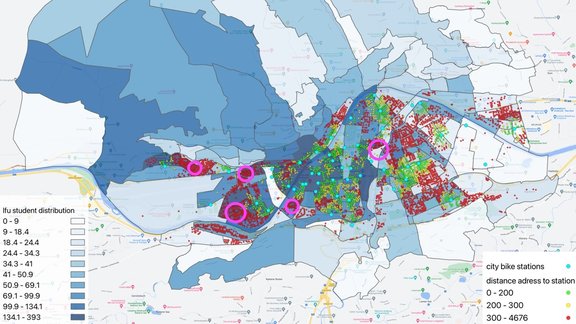Introduction
Students are among the top user groups of Stadtrad Innsbruck, the bike sharing system in Innsbruck operated by IVB in cooperation with nextbike that offers citybikes for rent. Our data-driven approach to enhancing the existing citybike network is specifically tailored to cater to their needs. Crucial to this enhancement is the positioning of the rental stations. If their departure and destination points are near rental stations, customers are more likely to use the service. Since citybikes are primarily used in the process of commuting, station sites should be close to transport hubs, workplaces and residences.
University locations and main transport hubs in Innsbruck are already well accessible through citybike. What remains is the optimization of the connections between where students live and bike station locations. To this end, we must identify areas with a high concentration of residing students and determine if these areas have sufficient access to citybikes. To achieve this, we first estimate the distribution of student residences in Innsbruck with the help of anonymized student address data. Then we determine how satisfactory the connections to existing rental stations are for the various residential areas, using Google Maps API. In addition, we perform a user data analysis based on nextbike riding data from 2021 to 2023. This gives insights into the riding behavior of our target group, a prerequisite for uncovering further location requirements.
Finding a suitable modeling approach
We first subdivide Innsbruck by means of a fine grid. We use the census district (Austrian term: Zählsprengel) as a subdivisional unit. This unit is also used by Austrian statistical authorities, so it enables us to compare our results to government data. The student population and average walking distance to the nearest citybike station in each census district is then estimated using the strains of data mentioned above. Regions with a high occurrence of students who presumably have an unsatisfactory connection to the citybike network are most promising for the positioning of new citybike stations.
Estimating the housing distribution of students
The housing distribution of Innsbruck university students is estimated based on a dataset from the University of Innsbruck which reveals the number of registered students per street in the city (for example: Sample Street - 17 students). This anonymized address data format ensures compliance with stringent data privacy regulations, but comes at the cost of information loss. More specifically, when certain streets span multiple census districts, precise mapping of student addresses to the correct area becomes impossible, necessitating distributional estimates. Since location, building size and apartment rental price vary only little within a street, we can assume that each address is equally appealing for student accommodation. This allows the conclusion that student housing can be considered uniformly distributed among residential buildings of a street. Student residence complexes are certainly an exception to this rule, but our investigation has shown that any resulting distortion is minor and only occurs at a local level. We hold that a reasonable way to assign the given student-address data to a census district is by theoretically distributing the number of students uniformly among residential buildings on a given street and mapping the resulting numbers to the census district assigned to the address. The resulting distribution is presented in Figure 1. Darker shades of blue indicate a higher concentration of students. Green dots show the location of student residences in their respective size. We can see that not only do student residences account for a higher concentration of students, but also that central and western Innsbruck are favored university student living areas.
Evaluating Innsbruck’s citybike network accessibility
Google Maps proves to be a robust and dependable tool for distance measurements between two points and offers a suite of APIs ideal for our project. To determine the minimum distance from an address to the nearest citybike station, we can simply calculate pedestrian routes to all citybike stations using the Google Cloud Platform's Distance Matrix API and reduce them to their minimum. Navigational errors yielding wrong measurements are easily identified as outliers when compared to the actual neighborhood.
To evaluate the connectivity of census disctricts to the citybike network, we use a straightforward approach, calculating the average of all distances between residential buildings and citybike stations within this specific area. This process is visually depicted in Figure 2, where lines denote distance measurements and colors categorize their respective lengths.
The colored segments represent the census districts under consideration. Their shading indicates how satisfactory their quality of connection to the bike network currently is. It is important to note here that measurements apply exclusively to level areas. Experience has shown that the appeal of riding citybikes uphill is limited, which is why citybike stations are not positioned beyond these level regions. We can observe that the areas best accessible by citybike are the central areas in Innsbruck.
Results
To narrow down the set of candidate locations for new citybike stations, we disregard census districts that have an acceptable average connection of up to 300 meters to the citybike network (equivalent to a five-minute walk). Analyzing the riding data from Stadtrad Innsbruck further reveals that Innsbruck's students favor rides lasting 15 minutes or less, with their most frequented stations typically situated near university campuses. Therefore, our final area proposals are made based on their proximity to the nearest primary university building and on the high number of students we presume them to house. Figure 3 depicts these findings: Shaded areas on the map represent the housing distribution of university students in Innsbruck. Colored dots indicate the accessibility of citybikes to residential buildings. Pink circles mark the areas we propose for setting up new citybike stations.
Conclusion and outlook
Transport companies sometimes struggle to provide convincing justification for demanding specific locations in public space. This project demonstrates how simple data-analytic approaches can assist in creating objective arguments to this end and supporting a decision-maker's work. After reviewing the report, we were told that the IVB plans to construct new rental stations in two out of the five proposed regions.
This work is licensed under a Creative Commons Attribution 4.0 International License.
This blog post is based on a student project carried out by Daniel Hillebrand and Kilian Epple. The project was conducted in the final module of the Minor Digital Science, namely in the 198888 PJ Data Analysis Lab: Applied Project in summer semester 2023, and was supervised by Adam Jatowt and Francesca Finotello. The guest blog post was written in November/December 2023.
Daniel Hillebrand
Student at the University of Innsbruck until February 2024 (expected graduation)
Bachelor's program in Mathematics
About the author
I am a mathematics student at the University of Innsbruck with a high passion for data science. My fields of interest include mathematical modeling and optimization, big data and logistics.
About the author
I am a data science student at the University of Salzburg. The Minor Digital Science, including this project, at the University of Innsbruck allowed me to make the switch from psychology to data science.







